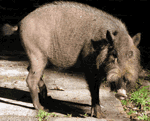 The bearded pig (Sus barbatus) has the smallest torso and the largest head of all pigs, it is about 5 - 6 feet long and has a tail that is about 20 - 30 centimeters long. They are omnivores and are known to trail monkeys (gibbons and macaques) to catch fallen fruit, scraps and offal. They exist in the wild on the islands of Malaysia, Sumatra and Borneo in Asia. Bearded Pigs inhabit rainforests, mangrove thickets, and secondary forests. It is the only species of pig which forms large groups to make long distance migrations. They get their name from the abundant winkers on its chin and several warts beneath its eyes. Their main predators are tigers, leopards and pythons.
The bearded pig (Sus barbatus) has the smallest torso and the largest head of all pigs, it is about 5 - 6 feet long and has a tail that is about 20 - 30 centimeters long. They are omnivores and are known to trail monkeys (gibbons and macaques) to catch fallen fruit, scraps and offal. They exist in the wild on the islands of Malaysia, Sumatra and Borneo in Asia. Bearded Pigs inhabit rainforests, mangrove thickets, and secondary forests. It is the only species of pig which forms large groups to make long distance migrations. They get their name from the abundant winkers on its chin and several warts beneath its eyes. Their main predators are tigers, leopards and pythons.
The Bearded pig is listed as Least Concern (LR/lc), lowest risk. Does not qualify for a more at risk category. Widespread and abundant taxa are included in this category, on the IUCN Red List of Threatened Species
Namings for the bearded pig
A young / baby of a bearded pig is called a 'piglet, shoat, bonham or gilt(female)'. The females are called 'sow' and males 'boar'. A bearded pig group is called a 'herd, drove or mob'.Some facts about the
Bearded pig
Adult weight : 102.75 kg (226.05 lbs)
Maximum longevity : 16 years
Gestation : 122 days
Litter size : 4

Custom Search